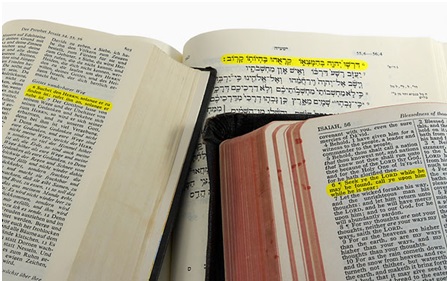Translations can change the history of a country as well as its creed. Sacred books such as the Bible are considered to be the word of God. Nevertheless the original Scriptures have been translated several times and the meaning of some concepts and idioms vary in different versions. An example of this can be seen in the verses about a strange woman (Proverbs 23:27). According to the original Hebrew Scripture, the strange woman is a non-Jewish woman but the meaning has changed in different Biblical versions varying from wayward wife to promiscuous woman. And this is not an isolated case.

Through the centuries, the Bible has been translated several times from Hebrew and Aramaic into Greek, Latin and many other languages. The translations have continued during the modern days. As a result, on 31 December 2007 the whole book was available in 438 languages. Surprisingly, there are over 450 English versions of the Bible.
The translation of sacred books is a difficult task because in addition to linguistic issues there are theological issues that are a major concern for believers.
What makes a Bible translation accurate? It is difficult to answer this question due to the fact that there is no unique approach to translation. The most common linguistic approaches that have been used to translate the Bible are:
• Formal Translation: word for word translation
• Dynamic Translation: the original message is adapted into the target language.
• Paraphrastic Translation: restatement of a text or passages, using other words.
The Bible translators have ranged from an extreme use of formal equivalence, to extreme use of dynamic equivalence. Certainly, there are a number of good translations such as the King James Version or the New World Translation. However, the search for the most accurate Bible is a never ending process that has engaged linguistics, theologian and historians and hasn’t really produced a unique answer.
How government agencies hire translators?
Believers might easily be misled by the number of Bible translations. In order to avoid this confusion, we advice to find the relevant information background that would show a date of translation and a particular approach used.
Book translation is a very complex task, particularly if it involves elements such as creed and faith while there is no access to the original texts. The problem with biblical translations is that many of them are revisions of the previous versions. For instance, Christian translations tend to be based on Hebrew, while other modern translations rely on Greek manuscripts translated from the original Hebrew texts.
Due to fact that the original Scriptures were written centuries ago, the deep- understanding about history is a prerequisite alongside with an outstanding knowledge of the source language.
One question that concern Bible readers is why there are so many Bible translations? The new versions have been carried out to update the scriptures into the living language and, therefore, to make it more accessible to contemporary readers. Dr. Lewis Foster, Bible translator says, “It is necessary to continue making new translations and revising old ones if people are to read the Word of God in their contemporary languages. With the passage of time, words change in meanings”.
